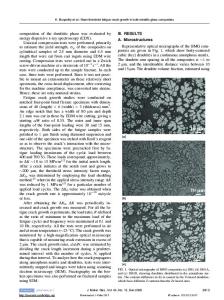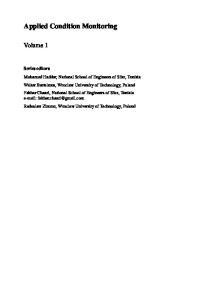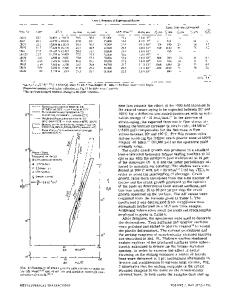Mixed-Mode and Mode-II Fatigue Crack Growth in Woven Composites
A woven carbon/epoxy composite was subjected to fatigue crack growth under mixed Mode-I/Mode-II loading to obtain crack growth behavior at different cyclic strain energies. Owing to the woven structure of the material, pure Mode-II fracture is usually a d
- PDF / 927,752 Bytes
- 11 Pages / 595.276 x 790.866 pts Page_size
- 43 Downloads / 350 Views
Mixed-Mode and Mode-II Fatigue Crack Growth in Woven Composites Joel S. Fenner and Isaac M. Daniel Abstract A woven carbon/epoxy composite was subjected to fatigue crack growth under mixed Mode-I/Mode-II loading to obtain crack growth behavior at different cyclic strain energies. Owing to the woven structure of the material, pure Mode-II fracture is usually a difficult proposition because of friction, interference, and interlock of woven tows in adjacent plies at an interlaminar crack. These limitations were overcome by the use of a novel form of mixed Mode-I/Mode-II specimen, which imposes sufficient crack surface opening (Mode-I) to alleviate ply–ply interactions, but not so much as to obscure the sliding (Mode-II) response. Comparison with pure Mode-I fatigue crack growth data, in conjunction with a fracture interaction criterion, provided a means to extract the Mode-II behavior. Keywords Composites • Fracture • Fatigue • Mixed-Mode • Test Methods
10.1
Introduction
Composites comprised of woven fibers embody a significant portion of commercial composite material production, owing to the high performance of finished parts and the relative ease of handling the raw materials (preforms, prepreg). However, in spite of their unquestionable practicality, the additional geometric complexity introduced by the woven structure of the fibers (crimps) in such composites has many confounding consequences on the characterization and testing of these materials. In the case of fracture, the complexity of the woven structure has different effects depending on the mode of crack propagation. For instance, in the case of Mode-I crack growth (opening mode), the propagation of an interlaminar crack around the crimps of the woven structure has an effect of introducing significant tortuosity to the crack path, and this often will manifest itself as a ‘stepwise’ or ‘zig–zag’ load-displacement character in comparison to a more uniform unidirectional material (Fig. 10.1) that lacks the more complicated geometry of the fiber arrangement. Such effects can often be accommodated reasonably well in data analysis by averaging methods which look at overall material response rather than local behavior at any given instant of crack propagation around a feature of the woven structure [1–3]. In the case of a Mode-II process (sliding mode), the situations is, however, quite worse. One of the more significant challenges in Mode-II fracture testing of woven composites is the ‘interlock’ phenomenon associated with the woven structure. In essence, the crimps of the fabric weave, in adjacent plies, have a strong tendency to physically interfere with one another, opposing sliding of one ply against another. Structurally, this is beneficial, as it presents a mechanism of resistance to the sliding motion required for extension of a crack in Mode-II (sliding mode) that is more robust than in unidirectional composites (Fig. 10.2). From a materials testing standpoint, however, it is quite confounding, as it prevents the successful execution of many forms of c
Data Loading...











